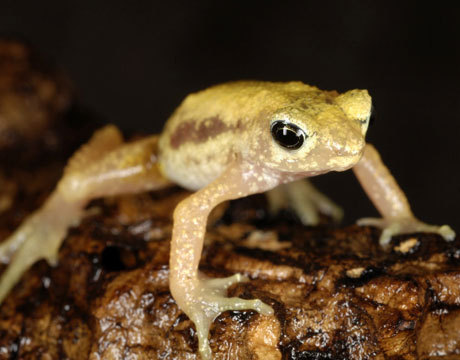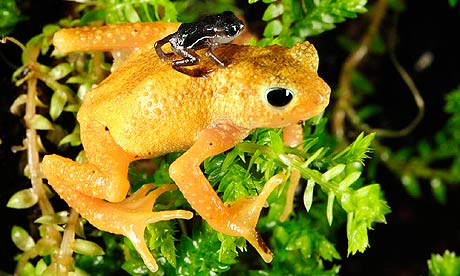Kihansi toads lived in the spray of a single waterfall before a major hydropower dam was built, But the Kihansi toad lives on thanks to the efforts of Tanzania and two American zoos. One hundred extremely rare Kihansi spray toads, a species last seen in Tanzania
in 2004 after their habitat was destroyed by a new hydroelectric dam,
have been flown home from the Bronx and Toledo zoos in the US.

|
Kihansi toads
|

|
A newborn Kihansi
spray toad clings to the back of an adult female at the Bronx Zoo in New
York.
|
They
were taken to a "state-of the-art propagation centre" in Dar es Salaam
where staff, presumably detecting a lot of tiny smiles, described the
toads as "cheerful".Well they might be. If all goes well they
will soon be returned to their parents' old hopping grounds, cooled by
an artificial sprinkler system to mimic their original misty home.

|
Kihansi toad
|
The species was first discovered in 1996 during an environmental
impact study for a large new hydroelectric dam in the Udzungwa
mountains, in southern Tanzania. The toads lived exclusively in a
five-acre zone under the spray of a waterfall.
Three years later
construction of the hydroelectric dam drastically reduced the
waterfall's flow, and the blanket of mist that gave the Kihansi spray
toads their name disappeared. Soon, so too did the amphibians. With no
sightings for five years, the toad was declared to be extinct in the
wild by the International Union for the Conservation of Nature.
Fortunately
the World Bank, which part funded the dam, and the Tanzanian government
had agreed on a plan in 1999 to try to ensure the species lived on. A
colony of 499 toads were taken from the gorge to the US zoos, where they
were bred in laboratories. They are now about 6,500 at the zoos.
Unusually among toads, the females do not lay eggs that hatch into
tadpoles, instead giving birth to fully formed young.Scientists
who worked on the project suspect that a combination of habitat loss,
exposure to pesticide, and the emergence of infective chytrid fungus led
to the toad's original demise in the wild.






No comments:
Post a Comment